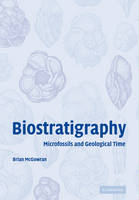
Biostratigraphy
Microfossils and Geological Time
Seiten
2008
Cambridge University Press (Verlag)
978-0-521-04817-0 (ISBN)
Cambridge University Press (Verlag)
978-0-521-04817-0 (ISBN)
Using fossils to tell geological time, biostratigraphy balances biology with geology. This important modern synthesis explores the origins and development of the subject, and the surprisingly wide application of biostratigraphic methods. Essential reading for advanced students and researchers working in basin analysis, sequence stratigraphy, palaeoceanography, palaeobiology and related fields.
Using fossils to tell geological time, biostratigraphy balances biology with geology. In modern geochronology - meaning timescale-building and making correlations between oceans, continents and hemispheres - the microfossil record of speciations and extinctions is integrated with numerical dates from radioactive decay, geomagnetic reversals through time, and the cyclical wobbles of the earth-sun-moon system. This important modern synthesis follows the development of biostratigraphy from classical origins into petroleum exploration and deep-ocean drilling. It explores the three-way relationship between species of microorganisms, their environment and their evolution through time as expressed in skeletons preserved as fossils. This book is essential reading for advanced students and researchers working in basin analysis, sequence stratigraphy, palaeoceanography, palaeobiology and related fields.
Using fossils to tell geological time, biostratigraphy balances biology with geology. In modern geochronology - meaning timescale-building and making correlations between oceans, continents and hemispheres - the microfossil record of speciations and extinctions is integrated with numerical dates from radioactive decay, geomagnetic reversals through time, and the cyclical wobbles of the earth-sun-moon system. This important modern synthesis follows the development of biostratigraphy from classical origins into petroleum exploration and deep-ocean drilling. It explores the three-way relationship between species of microorganisms, their environment and their evolution through time as expressed in skeletons preserved as fossils. This book is essential reading for advanced students and researchers working in basin analysis, sequence stratigraphy, palaeoceanography, palaeobiology and related fields.
Preface; Acknowledgements; 1. Biogeohistory and the development of classical biostratigraphy; 2. The biostratigraphy of fossil microplankton; 3. Biostratigraphy: its integration into modern geochronology; 4. Biostratigraphy and biohistorical theory I: evolution and correlation; 5. Systemic stratigraphy: beyond classical biostratigraphy; 6. Biostratigraphy and biohistorical theory II: carving nature at the joints; 7. Biostratigraphy and chronostratigraphic classification; 8. On biostratigraphy and biogeohistory; References; Index.
| Erscheint lt. Verlag | 1.1.2008 |
|---|---|
| Zusatzinfo | 34 Halftones, unspecified; 164 Line drawings, unspecified |
| Verlagsort | Cambridge |
| Sprache | englisch |
| Maße | 170 x 241 mm |
| Gewicht | 756 g |
| Themenwelt | Naturwissenschaften ► Geowissenschaften ► Geologie |
| Naturwissenschaften ► Geowissenschaften ► Mineralogie / Paläontologie | |
| ISBN-10 | 0-521-04817-6 / 0521048176 |
| ISBN-13 | 978-0-521-04817-0 / 9780521048170 |
| Zustand | Neuware |
| Haben Sie eine Frage zum Produkt? |
Mehr entdecken
aus dem Bereich
aus dem Bereich


